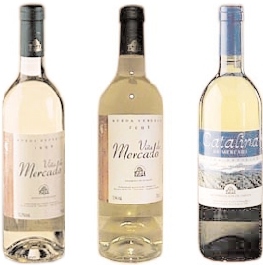|
White wine differs from red wine in, first
and most obviously, color. Under that skin, the pulpy part of a white
grape is the same color as that of a red grape. The skin dictates the
end color for red wine, which differs from the white's color
determinates.
This is mainly due to the pressing of the
grapes. When white grapes are picked, they are immediately pressed and
the juice is removed from the skins with little contact.
Color in white wine does vary, often from
the type of grape, occasionally from the use of wood. Listed below are a
few of the most common white varieties in the world wine market and of
wine.com. They are listed from lighter bodied, and lighter colored, to
fuller bodied with deeper colors. The list is not set in stone –
winemaker's decisions and climate may affect the end result of a white
wine's body and color – we just give you the guidelines.

|
Grapes/Region |
Where primarily grown |
| Champagne |
Champagne, France |
| Pinot Grigio/Pinot Gris |
Alsace, France; Italy; Oregon;
California |
| Sauvignon Blanc |
Loire, France; New Zealand;
California; South Africa |
| Chenin Blanc |
Loire, France; South Africa |
| Riesling |
Germany; Alsace, France;
Australia; New Zealand; Washington State; California |
| Chardonnay |
Burgundy, France; Australia;
California; South America; South Africa; Oregon |
| Viognier |
Rhone, France; California |
Other white grapes to notice, listed
alphabetically:
| Grapes |
Where they grow best |
| Albariño |
Spain |
|
| Gewurztraminer |
Alsace, France; Germany |
| Sémillon |
Bordeaux, France; Australia |
|
 |